Synthesis of Acetobacter xylinum Bacterial Cellulose Aerogels and Their Effect on the Selected Properties
Abstract
1. Introduction
2. Results and Discussion
2.1. Geometrical Characterization
2.2. Scanning Electron Microscopy (SEM) Analysis
2.3. Surface Roughness Analysis
2.4. Water Contact Angle (WCA) Analysis
2.5. Analysis of Young’s Modulus Under Different Loads
2.6. Thermal Conductivity
3. Conclusions
4. Materials and Methods
4.1. Materials
4.2. Fabrication of BC Pellicles
4.3. Morphology
4.4. Surface Roughness
4.5. Characterization of Water Contact Angle
4.6. Young’s Modulus Under Different Loads
4.7. Thermal Conductivity (Alambeta)
4.8. Porosity Determination
4.9. Statistical Analysis
Author Contributions
Funding
Institutional Review Board Statement
Informed Consent Statement
Data Availability Statement
Conflicts of Interest
References
- Rebelo, A.R.; Archer, A.J.; Chen, X.; Liu, C.; Yang, G.; Liu, Y. Dehydration of Bacterial Cellulose and the Water Content Effects on Its Viscoelastic and Electrochemical Properties. Sci. Technol. Adv. Mater. 2018, 19, 203–211. [Google Scholar] [CrossRef] [PubMed]
- Choi, S.M.; Rao, K.M.; Zo, S.M.; Shin, E.J.; Han, S.S. Bacterial Cellulose and Its Applications. Polymers 2022, 14, 1080. [Google Scholar] [CrossRef] [PubMed]
- Cazón, P.; Velázquez, G.; Vázquez, M. Bacterial Cellulose Films: Evaluation of the Water Interaction. Food Packag. Shelf Life 2020, 25, 100526. [Google Scholar] [CrossRef]
- Nainggolan, H.; Gea, S.; Bilotti, E.; Peijs, T.; Hutagalung, S.D. Mechanical and Thermal Properties of Bacterial-Cellulose-Fibre-Reinforced Mater-Bi® Bionanocomposite. Beilstein J. Nanotechnol. 2013, 4, 325–329. [Google Scholar] [CrossRef]
- Revin, V.V.; Nazarova, N.B.; Tsareva, E.E.; Liyaskina, E.V.; Revin, V.D.; Pestov, N.A. Production of Bacterial Cellulose Aerogels With Improved Physico-Mechanical Properties and Antibacterial Effect. Front. Bioeng. Biotechnol. 2020, 8, 603407. [Google Scholar]
- Hussain, Z.; Sajjad, W.; Khan, T.; Wahid, F. Production of Bacterial Cellulose from Industrial Wastes: A Review. Cellulose 2019, 26, 2895–2911. [Google Scholar] [CrossRef]
- Abol-Fotouh, D.; Hassan, M.A.; Shokry, H.; Roig, A.; Azab, M.S.; Kashyout, A.E.-H.B. Bacterial Nanocellulose from Agro-Industrial Wastes: Low-Cost and Enhanced Production by Komagataeibacter saccharivorans MD1. Sci. Rep. 2020, 10, 3491. [Google Scholar] [CrossRef]
- Barja, F. Bacterial Nanocellulose Production and Biomedical Applications. J. Biomed. Res. 2021, 35, 310–317. [Google Scholar] [CrossRef]
- Tsouko, E.; Pilafidis, S.; Kourmentza, K.; Gomes, H.I.; Sarris, G.; Koralli, P.; Papagiannopoulos, A.; Pispas, S.; Sarris, D. A Sustainable Bioprocess to Produce Bacterial Cellulose (BC) Using Waste Streams from Wine Distilleries and the Biodiesel Industry: Evaluation of BC for Adsorption of Phenolic Compounds, Dyes and Metals. Biotechnol. Biofuels Bioprod. 2024, 17, 40. [Google Scholar] [CrossRef]
- Surma-Ślusarska, B.; Presler, S.; Danielewicz, D. Characteristics of Bacterial Cellulose Obtained from Acetobacter Xylinum Culture for Application in Papermaking. Fibres Text. East. Eur. 2008, 16, 108–111. [Google Scholar]
- Vasconcellos, V.; Farinas, C. The Effect of the Drying Process on the Properties of Bacterial Cellulose Films from Gluconacetobacter Hansenii. Chem. Eng. Trans. 2018, 64, 145–150. [Google Scholar] [CrossRef]
- Illa, M.P.; Sharma, C.S.; Khandelwal, M. Tuning the Physiochemical Properties of Bacterial Cellulose: Effect of Drying Conditions. J. Mater. Sci. 2019, 54, 12024–12035. [Google Scholar] [CrossRef]
- Zhang, X.; Yu, Y.; Jiang, Z.; Wang, H. The Effect of Freezing Speed and Hydrogel Concentration on the Microstructure and Compressive Performance of Bamboo-Based Cellulose Aerogel. J. Wood Sci. 2015, 61, 595–601. [Google Scholar] [CrossRef]
- Ruan, J.-Q.; Xie, K.-Y.; Wan, J.-N.; Chen, Q.-Y.; Zuo, X.; Li, X.; Wu, X.; Fei, C.; Yao, S. Effects of Freeze-Drying Processes on the Acoustic Absorption Performance of Sustainable Cellulose Nanocrystal Aerogels. Gels 2024, 10, 141. [Google Scholar] [CrossRef] [PubMed]
- Mohamad, S.; Abdullah, L.C.; Jamari, S.S.; Al Edrus, S.S.O.; Aung, M.M.; Mohamad, S.F.S. Influence of Drying Method on the Crystal Structure and Thermal Property of Oil Palm Frond Juice-Based Bacterial Cellulose. J. Mater. Sci. 2022, 57, 1462–1473. [Google Scholar] [CrossRef]
- Liebner, F.; Potthast, A.; Rosenau, T.; Haimer, E.; Wendland, M. Cellulose Aerogels: Highly Porous, Ultra-Lightweight Materials. Holzforschung 2008, 62, 129–135. [Google Scholar] [CrossRef]
- Liebner, F.; Haimer, E.; Wendland, M.; Neouze, M.-A.; Schlufter, K.; Miethe, P.; Heinze, T.; Potthast, A.; Rosenau, T. Aerogels from Unaltered Bacterial Cellulose: Application of scCO2 Drying for the Preparation of Shaped, Ultra-Lightweight Cellulosic Aerogels. Macromol. Biosci. 2010, 10, 349–352. [Google Scholar] [CrossRef]
- Zeng, M.; Laromaine, A.; Roig, A. Bacterial Cellulose Films: Influence of Bacterial Strain and Drying Route on Film Properties. Cellulose 2014, 21, 4455–4469. [Google Scholar] [CrossRef]
- Al-shamary, E.E.; Al-Darwash, A.K. Influence of Fermentation Condition and Alkali Treatment on the Porosity and Thickness of Bacterial Cellulose Membranes. TOJSAT 2016, 3, 194–203. [Google Scholar]
- Jiang, F.; Hsieh, Y.-L. Super Water Absorbing and Shape Memory Nanocellulose Aerogels from TEMPO-Oxidized Cellulose Nanofibrils via Cyclic Freezing–Thawing. J. Mater. Chem. A 2013, 2, 350–359. [Google Scholar] [CrossRef]
- Hamsan, M.H.; Halim, N.A.; Demon, S.Z.N.; Sa’aya, N.S.N.; Kadir, M.F.Z.; Abidin, Z.H.Z.; Poad, N.A.; Kasim, N.F.A.; Razali, N.A.M.; Aziz, S.B.; et al. SCOBY-Based Bacterial Cellulose as Free Standing Electrodes for Safer, Greener and Cleaner Energy Storage Technology. Heliyon 2022, 8, e11048. [Google Scholar] [CrossRef]
- Maryati, Y.; Melanie, H.; Handayani, W.; Yasman, Y. Bacterial Cellulose Production from Fermented Fruits and Vegetables Byproducts: A Comprehensive Study on Chemical and Morphological Properties. Karbala Int. J. Mod. Sci. 2024, 10, 7. [Google Scholar] [CrossRef]
- Chan, C.-W.; Carson, L.; Smith, G.C.; Morelli, A.; Lee, S. Enhancing the Antibacterial Performance of Orthopaedic Implant Materials by Fibre Laser Surface Engineering. Appl. Surf. Sci. 2017, 404, 67–81. [Google Scholar] [CrossRef]
- Tiainen, L.; Abreu, P.; Buciumeanu, M.; Silva, F.; Gasik, M.; Serna Guerrero, R.; Carvalho, O. Novel Laser Surface Texturing for Improved Primary Stability of Titanium Implants. J. Mech. Behav. Biomed. Mater. 2019, 98, 26–39. [Google Scholar] [CrossRef] [PubMed]
- Samanta, A.; Wang, Q.; Shaw, S.K.; Ding, H. Roles of Chemistry Modification for Laser Textured Metal Alloys to Achieve Extreme Surface Wetting Behaviors. Mater. Des. 2020, 192, 108744. [Google Scholar] [CrossRef]
- Venkataraman, M.; Mishra, R.; Militky, J.; Kremenakova, D.; Michal, P. Aerogel Based High Performance Thermal Insulation Materials. IOP Conf. Ser. Mater. Sci. Eng. 2019, 553, 012043. [Google Scholar] [CrossRef]
- Riveiro, A.; Maçon, A.L.B.; del Val, J.; Comesaña, R.; Pou, J. Laser Surface Texturing of Polymers for Biomedical Applications. Front. Phys. 2018, 6, 16. [Google Scholar] [CrossRef]
- Pirzada, T.; Ashrafi, Z.; Xie, W.; Khan, S.A. Cellulose Silica Hybrid Nanofiber Aerogels: From Sol–Gel Electrospun Nanofibers to Multifunctional Aerogels. Adv. Funct. Mater. 2020, 30, 1907359. [Google Scholar] [CrossRef]
- Gilmour, K.A.; Aljannat, M.; Markwell, C.; James, P.; Scott, J.; Jiang, Y.; Torun, H.; Dade-Robertson, M.; Zhang, M. Biofilm Inspired Fabrication of Functional Bacterial Cellulose through Ex-Situ and in-Situ Approaches. Carbohydr. Polym. 2023, 304, 120482. [Google Scholar] [CrossRef]
- Galdino, C.J.S.; Maia, A.D.; Meira, H.M.; Souza, T.C.; Amorim, J.D.P.; Almeida, F.C.G.; Costa, A.F.S.; Sarubbo, L.A. Use of a Bacterial Cellulose Filter for the Removal of Oil from Wastewater. Process Biochem. 2020, 91, 288–296. [Google Scholar] [CrossRef]
- Venkataraman, M.; Mishra, R.; Kotresh, T.M.; Sakoi, T.; Militky, J. Effect of Compressibility on Heat Transport Phenomena in Aerogel-Treated Nonwoven Fabrics. J. Text. Inst. 2016, 107, 1150–1158. [Google Scholar] [CrossRef]
- Revin, V.V.; Pestov, N.A.; Shchankin, M.V.; Mishkin, V.P.; Platonov, V.I.; Uglanov, D.A. A Study of the Physical and Mechanical Properties of Aerogels Obtained from Bacterial Cellulose. Biomacromolecules 2019, 20, 1401–1411. [Google Scholar] [CrossRef] [PubMed]
- Sozcu, S.; Frajova, J.; Wiener, J.; Venkataraman, M.; Tomkova, B.; Militky, J. Effect of Drying Methods on the Thermal and Mechanical Behavior of Bacterial Cellulose Aerogel. Gels 2024, 10, 474. [Google Scholar] [CrossRef] [PubMed]
- Sozcu, S.; Venkataraman, M.; Wiener, J.; Tomkova, B.; Militky, J.; Mahmood, A. Incorporation of Cellulose-Based Aerogels into Textile Structures. Materials 2024, 17, 27. [Google Scholar] [CrossRef]
- Fan, W.; Zhang, X.; Zhang, Y.; Zhang, Y.; Liu, T. Lightweight, Strong, and Super-Thermal Insulating Polyimide Composite Aerogels under High Temperature. Compos. Sci. Technol. 2019, 173, 47–52. [Google Scholar] [CrossRef]
- Zhang, X.; Zhao, X.; Xue, T.; Yang, F.; Fan, W.; Liu, T. Bidirectional Anisotropic Polyimide/Bacterial Cellulose Aerogels by Freeze-Drying for Super-Thermal Insulation. Chem. Eng. J. 2020, 385, 123963. [Google Scholar] [CrossRef]
- Onofrei, E.; Rocha, A.M.; Catarino, A. The Influence of Knitted Fabrics’ Structure on the Thermal and Moisture Management Properties. J. Eng. Fibers Fabr. 2011, 6, 10–22. [Google Scholar] [CrossRef]
- Gerzhova, N.; Côté, J.; Blanchet, P.; Dagenais, C.; Ménard, S. A Conceptual Framework for Modelling the Thermal Conductivity of Dry Green Roof Substrates. BioResources 2019, 14, 8573–8599. [Google Scholar] [CrossRef]
- Thermal Conductivity and Resistivity; Wikipedia: San Francisco, CA, USA, 2025.
- Fleury, B.; Abraham, E.; De La Cruz, J.A.; Chandrasekar, V.S.; Senyuk, B.; Liu, Q.; Cherpak, V.; Park, S.; ten Hove, J.B.; Smalyukh, I.I. Aerogel from Sustainably Grown Bacterial Cellulose Pellicles as a Thermally Insulative Film for Building Envelopes. ACS Appl. Mater. Interfaces 2020, 12, 34115–34121. [Google Scholar] [CrossRef]
- Hes, L. Thermal Properties of Nonwovens. In Proceedings of Congress Index; United States Senate: Washington, DC, USA, 1987. [Google Scholar]
- Mao, N. 6—Methods for Characterisation of Nonwoven Structure, Property, and Performance. In Advances in Technical Nonwovens; Kellie, G., Ed.; Woodhead Publishing Series in Textiles; Woodhead Publishing: Sawston, UK, 2016; pp. 155–211. ISBN 978-0-08-100575-0. [Google Scholar]
- Dolezal, I.; Hes, L.; Bal, K. A Non-Destructive Single Plate Method for Measurement of Thermal Resistance of Polymer Sheets and Fabrics. Int. J. Occup. Saf. Ergon. 2019, 25, 562–567. [Google Scholar] [CrossRef]
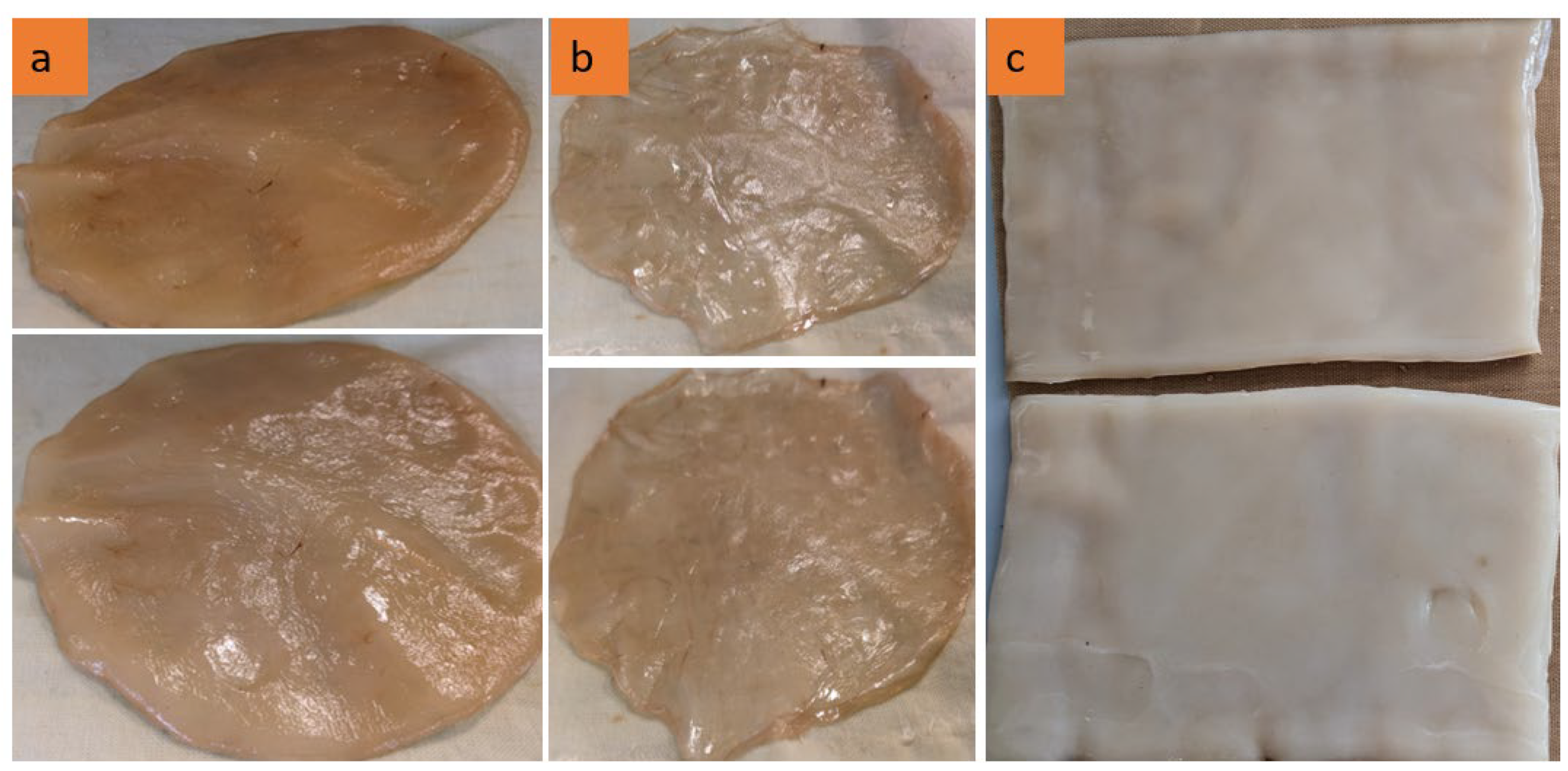
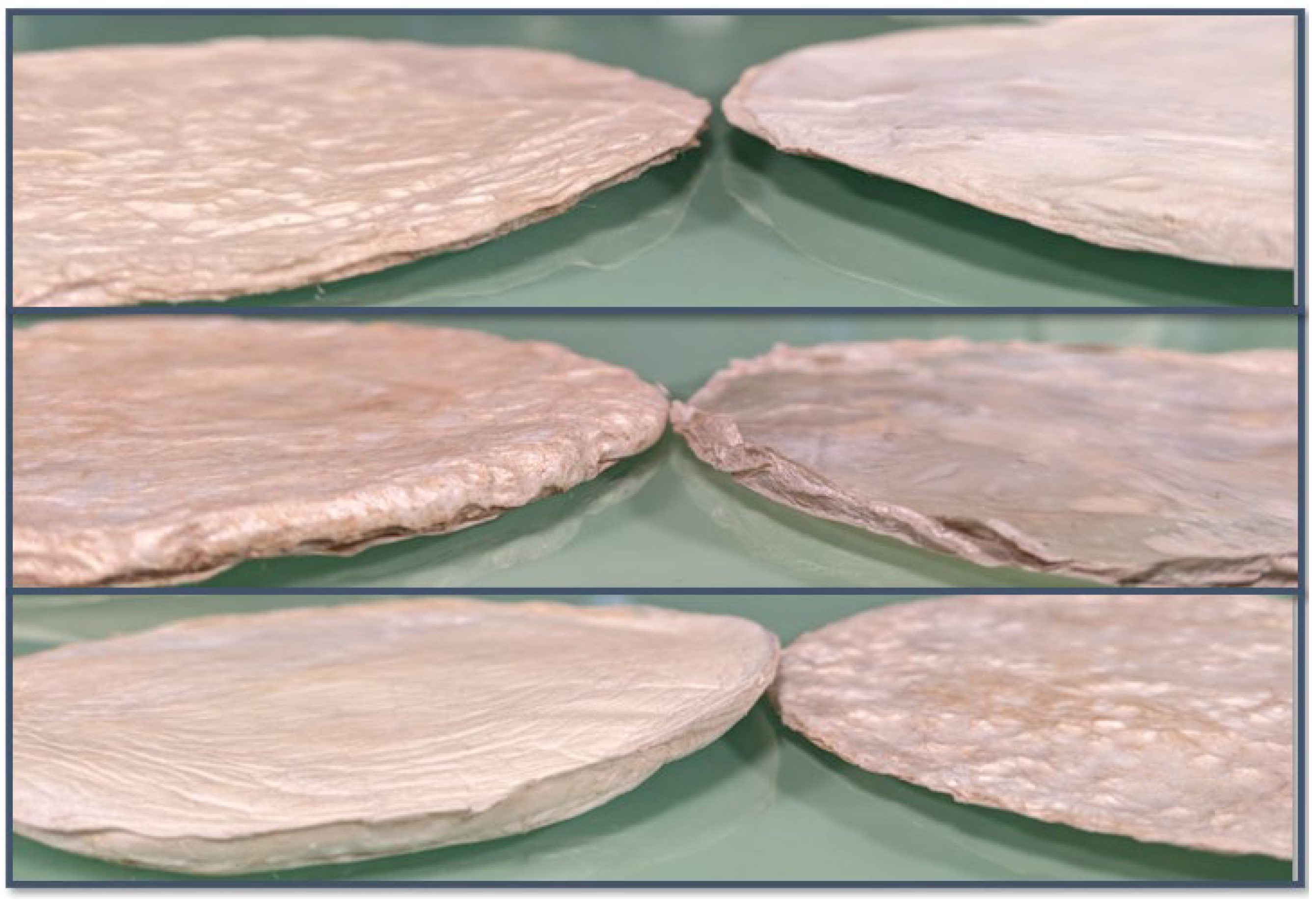

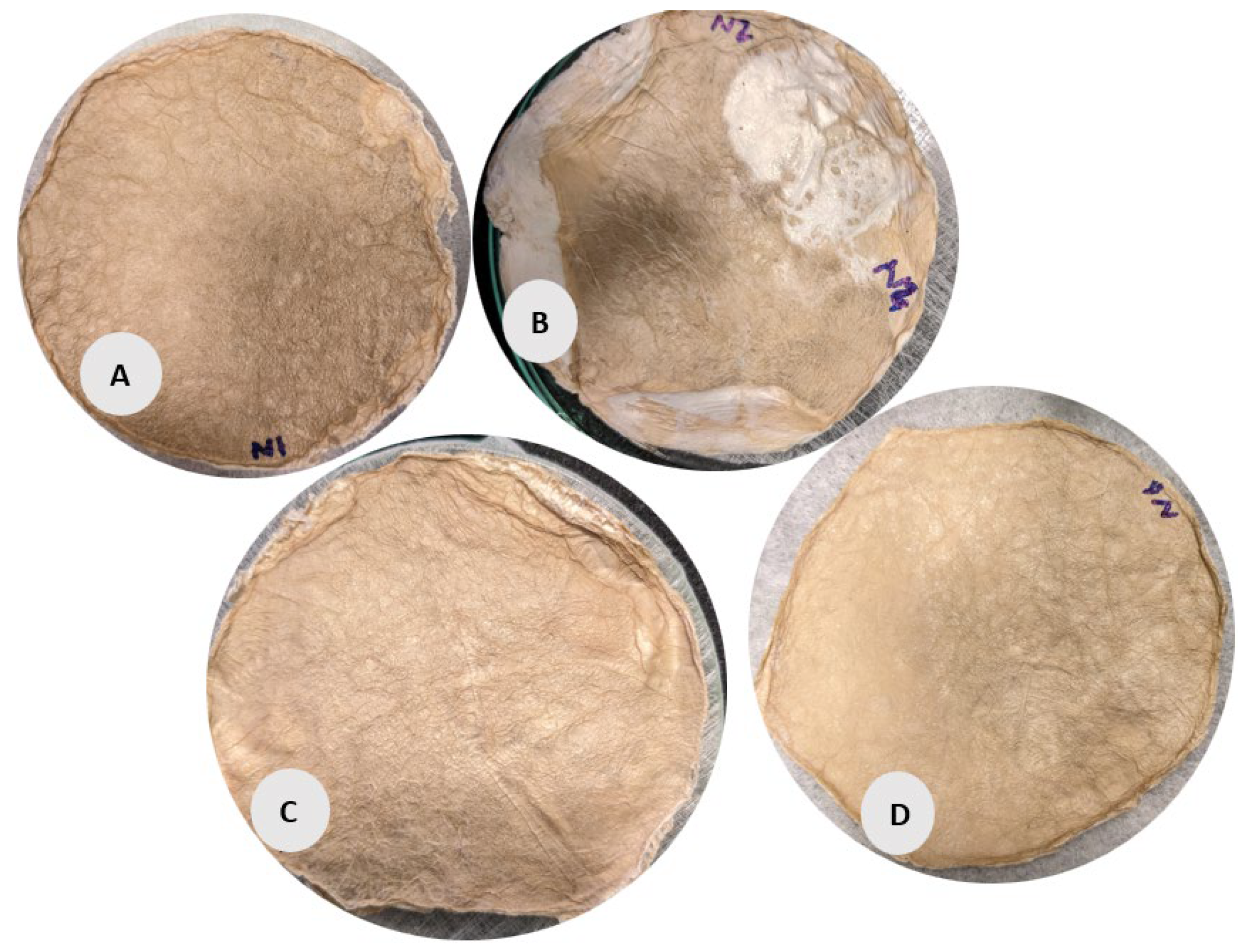


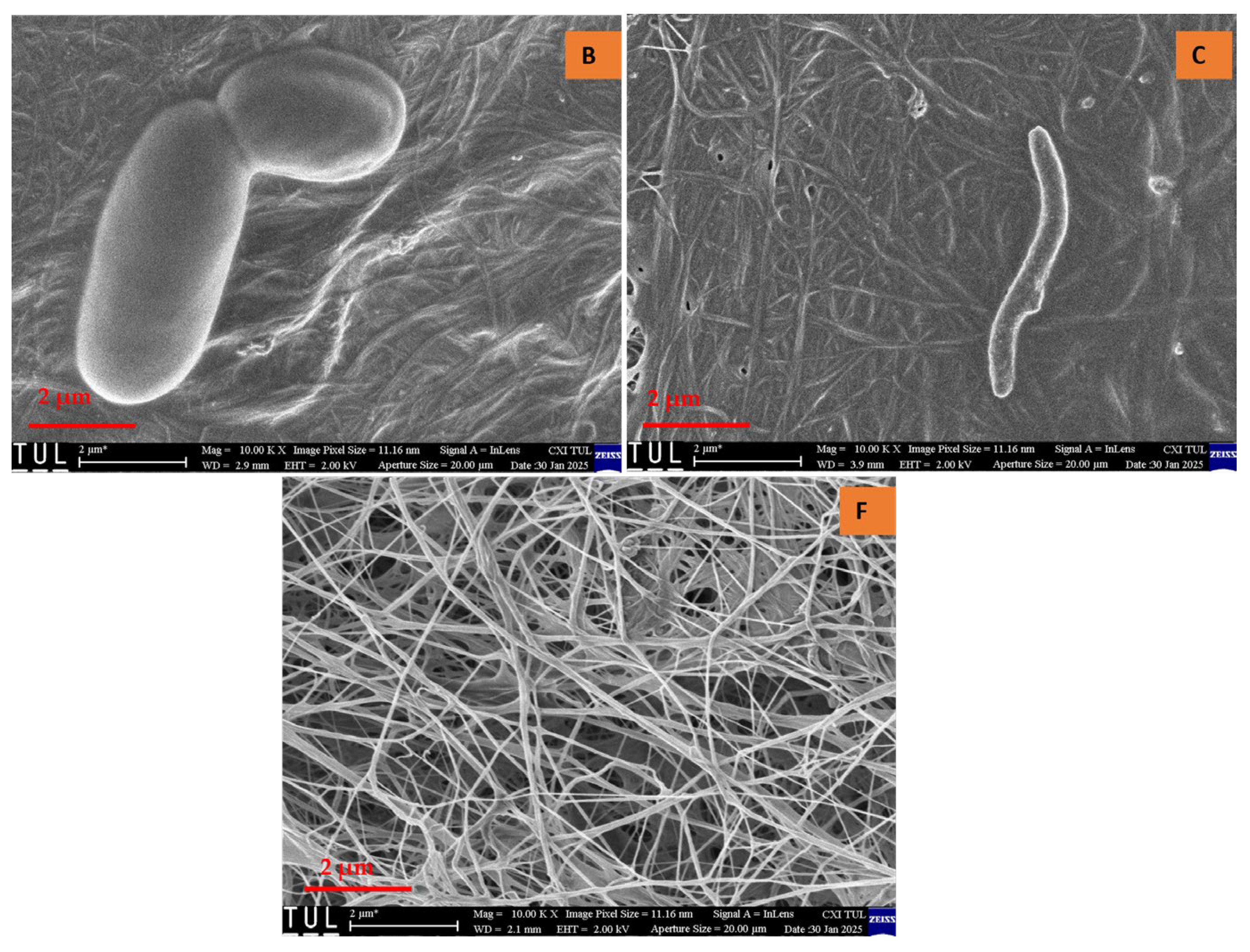
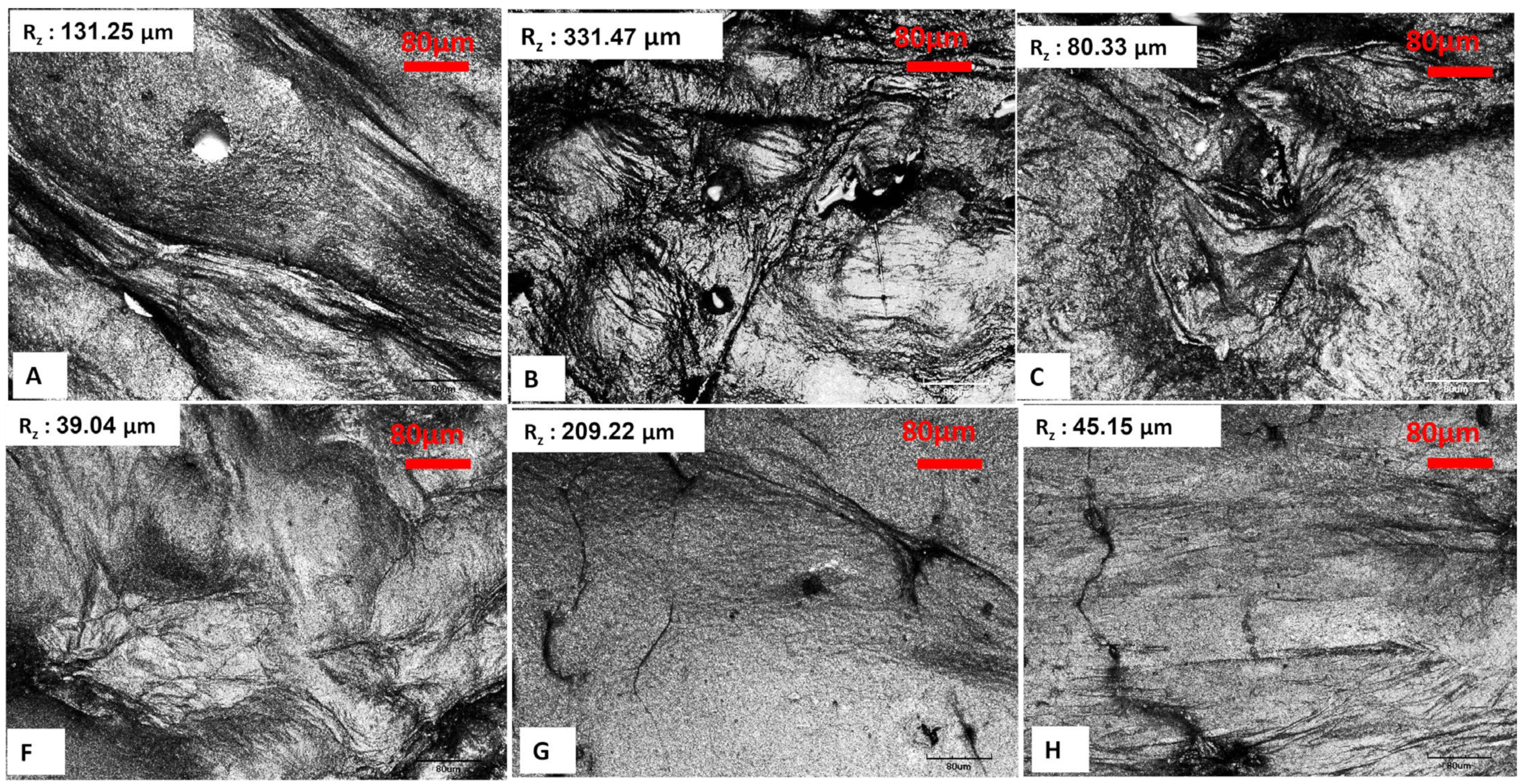
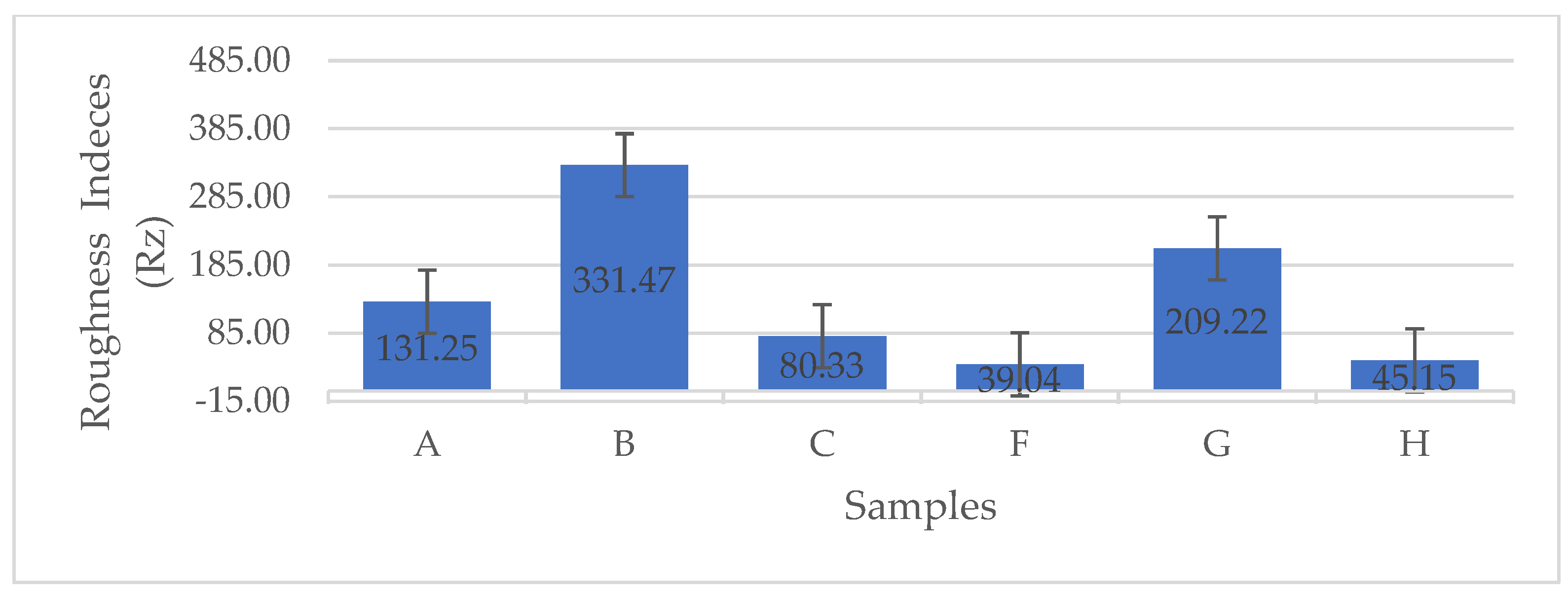


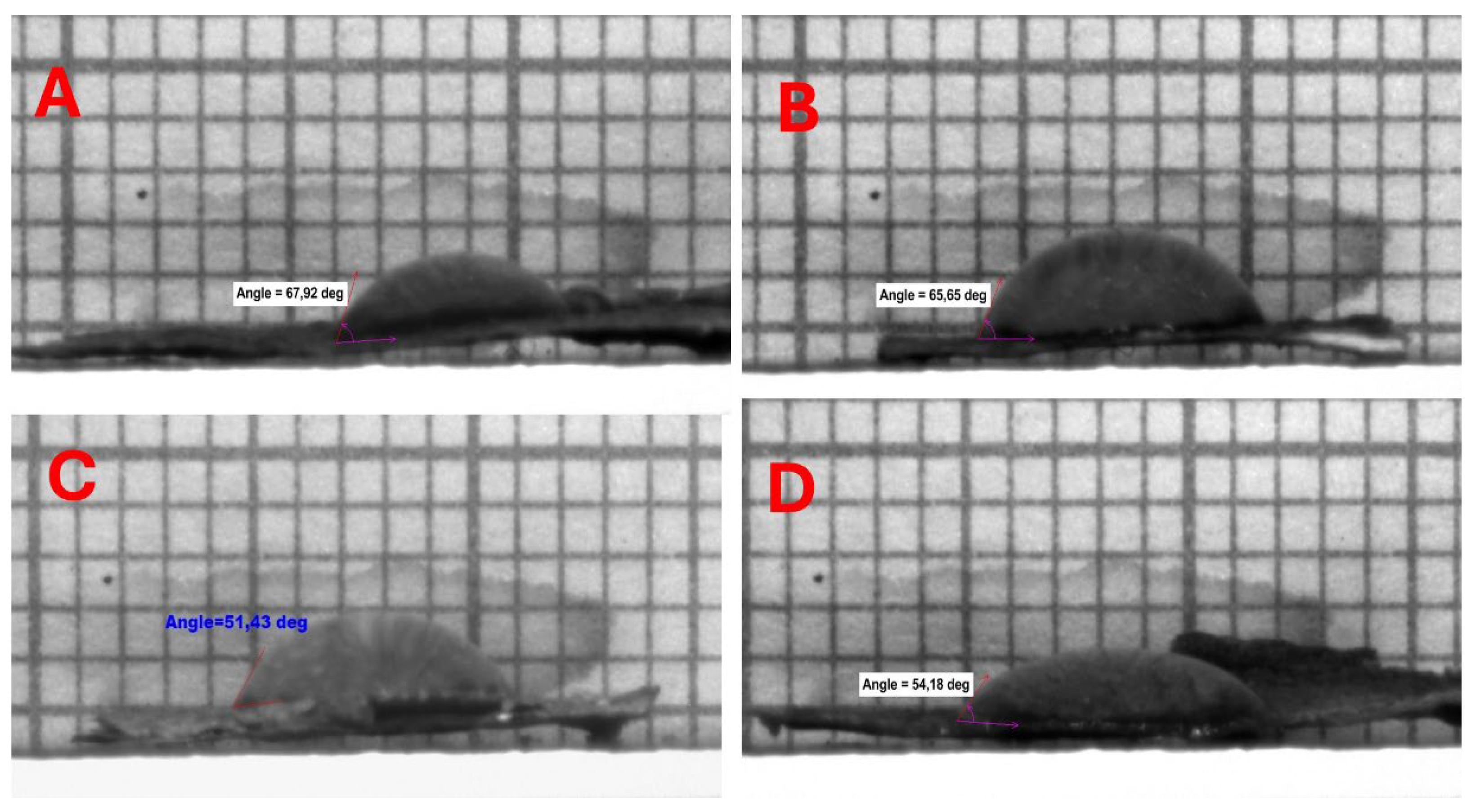
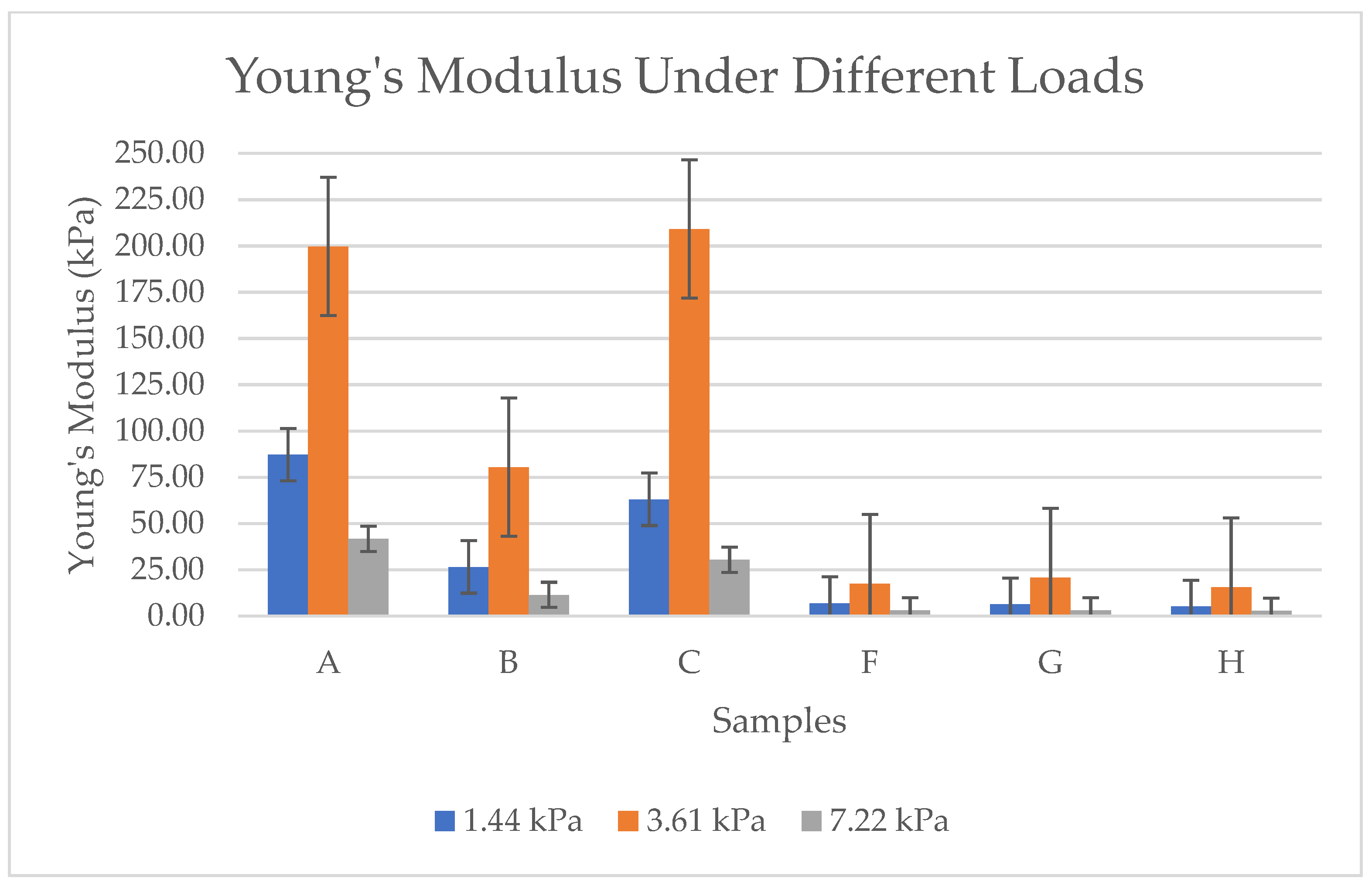
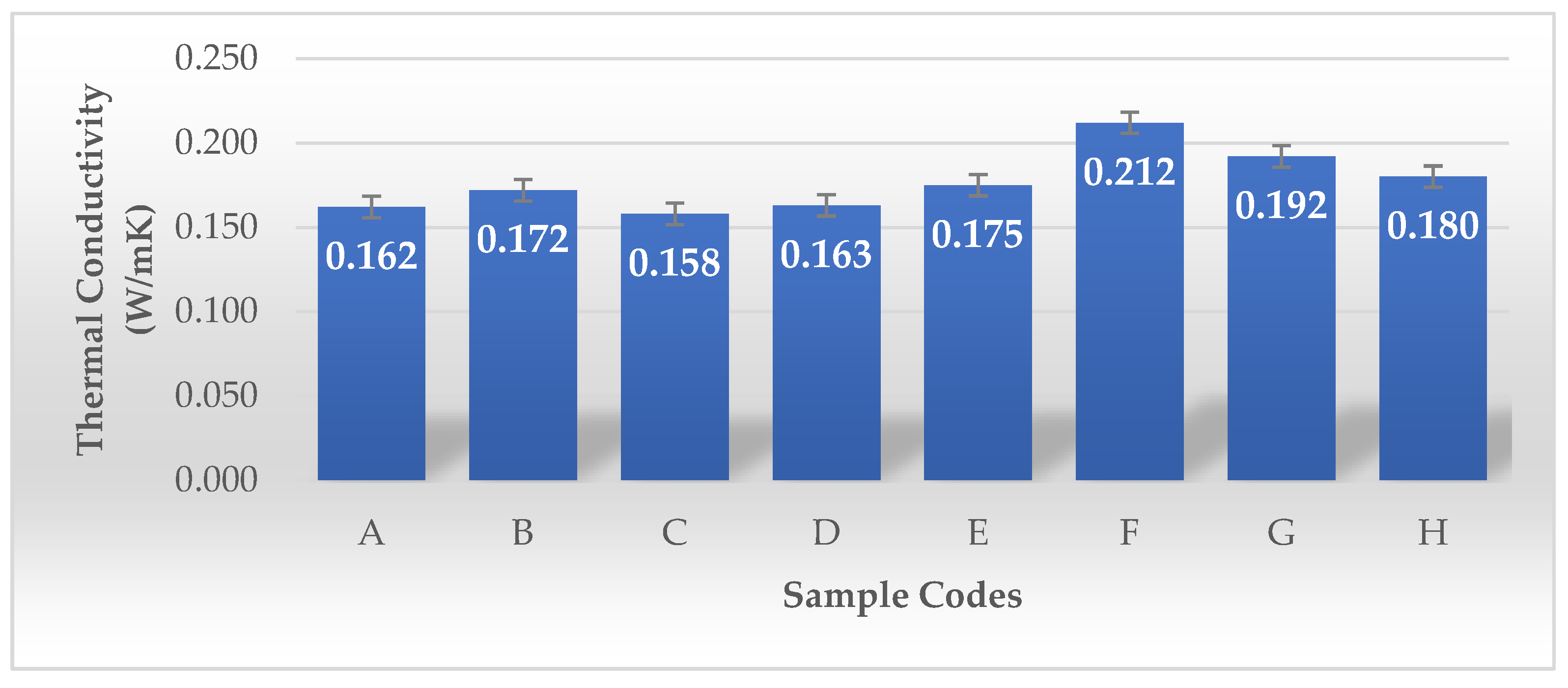

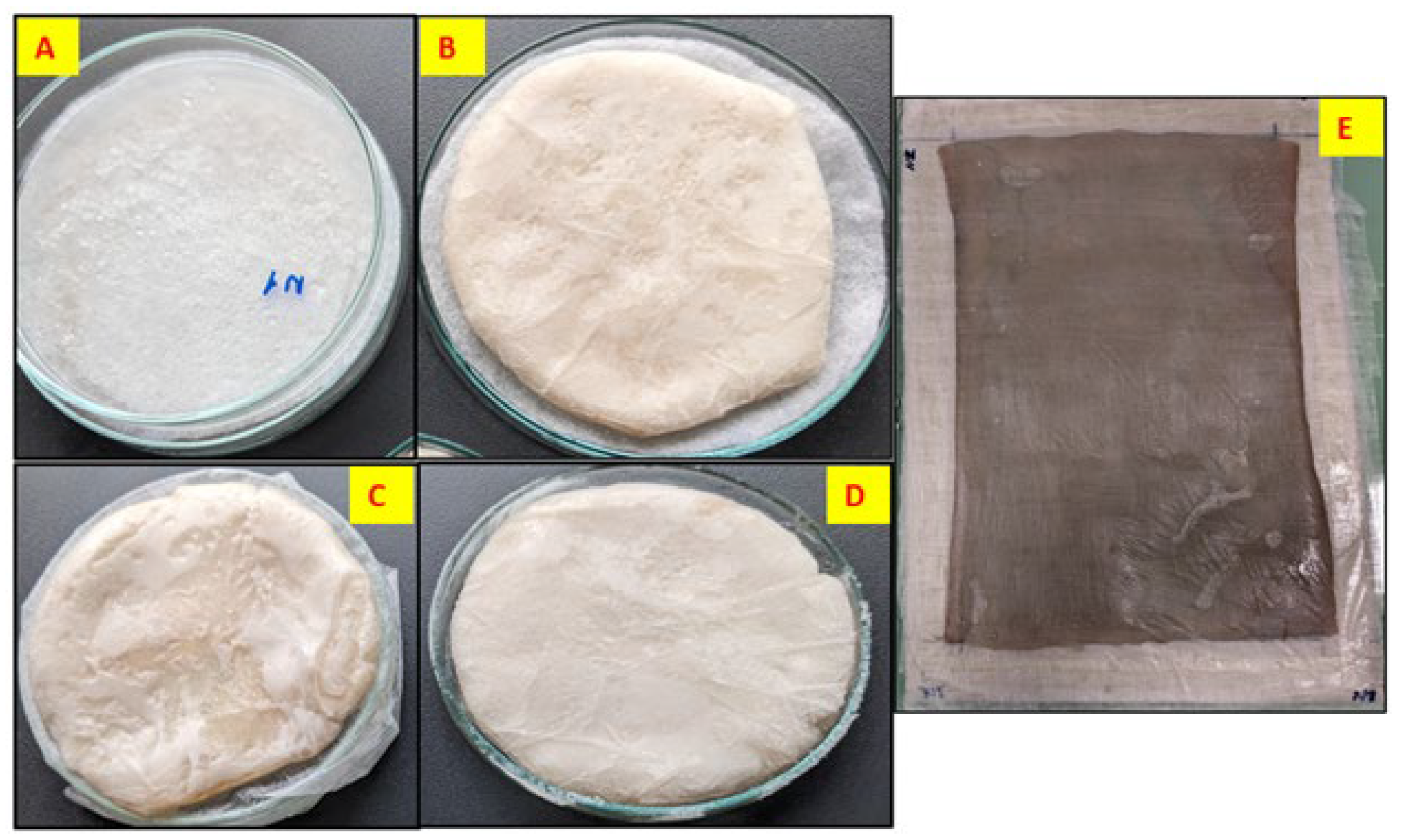

| Samples | Description | After Lyophilization | |||||||
|---|---|---|---|---|---|---|---|---|---|
| Dry Thickness (cm) | Dry Mass (g) | Volume Density (g/cm3) | Porosity (%) | Surface Area (cm2) | Dimension (cm) | Skeletal Density (g/cm3) | Shape | ||
| A | BC film placed between NW (15 GSM) fabrics | 0.45 | 0.592 | 31.88 | 98.81 | 70.85 | 4.75 | 1.24 | Circular |
| B | Bottom of the Petri dish placed on NW fabric (10 GSM), and BC film placed on it | 0.52 | 0.99 | 61.36 | 98.97 | 117.99 | 6.13 | 1.01 | Circular |
| C | Top of the Petri dish covered with NW fabric (10 GSM), and BC film placed on it | 0.56 | 0.35 | 48.47 | 99.54 | 86.55 | 5.25 | 1.12 | Circular |
| D | Bottom of the Petri dish placed on NW fabric (15 GSM), and BC film placed on it | 0.50 | 0.39 | 34.68 | 99.28 | 69.36 | 4.70 | 1.26 | Circular |
| E | BC film placed in plastic frame structure | 0.52 | 0.708 | 360.36 | 99.87 | 693.00 | 21 × 33 | 1.31 | Rectangular |
| F | LN2 pre-freezing using BC film | 0.72 | 2.92 | 181.63 | 99.99 | 252.96 | 13.6 × 18.6 | 0.22 | Rectangular |
| G | LN2 pre-freezing using BC film | 0.49 | 3.68 | 154.35 | 99.98 | 315.00 | 14 × 22.5 | 0.23 | Rectangular |
| H | LN2 pre-freezing using BC film | 0.27 | 3.85 | 93.60 | 99.97 | 344.10 | 15.5 × 22.2 | 0.51 | Rectangular |
| Porosity of BCAs used Conventional Pre-Freezing | ||||||
| Source of Variation | SS (Sum of Squares) | Df (Degrees of Freedom) | MS (Mean Square) | F (F-statistic) | p-Value (Probability) | F crit (Critical Value) |
| Between Groups | 0.00989956 | 4 | 0.002475 | 103.1738 | 4.69 × 10−13 | 2.866081 |
| Within Groups | 0.00047975 | 20 | 2.4 × 10−5 | |||
| Total | 0.01037932 | 24 | ||||
| Porosity of BCAs using Liquid Nitrogen Pre-Freezing | ||||||
| Source of Variation | SS | df | MS | F | p-Value | F crit |
| Between Groups | 0.000676 | 2 | 0.000338 | 23.49707 | 7.08 × 10−5 | 3.885293835 |
| Within Groups | 0.000173 | 12 | 1.44 × 10−5 | |||
| Total | 0.000849 | 14 | ||||
| Volume density of BCAs using Liquid Nitrogen Pre-Freezing | ||||||
| Source of Variation | SS | df | MS | F | p-Value | F crit |
| Between Groups | 20,307.3 | 2 | 10,153.65 | 10.16171 | 0.002618 | 3.885294 |
| Within Groups | 11,990.48 | 12 | 999.207 | |||
| Total | 32,297.79 | 14 | ||||
| Volume Density of BCAs using Conventional Pre-Freezing | ||||||
| Source of Variation | SS | df | MS | F | p-Value | F crit |
| Between Groups | 15,282.12 | 4 | 3820.53 | 297.5808 | 1.64 × 10−17 | 2.866081 |
| Within Groups | 256.7726 | 20 | 12.83863 | |||
| Total | 15,538.89 | 24 | ||||
| Thicknesses of BCAs using Liquid Nitrogen Pre-Freezing | ||||||
| Source of Variation | SS | df | MS | F | p-Value | F crit |
| Between Groups | 0.497373 | 2 | 0.248687 | 23.46839 | 7.12 × 10−05 | 3.885294 |
| Within Groups | 0.12716 | 12 | 0.010597 | |||
| Total | 0.624533 | 14 | ||||
| Thicknesses of BCAs using Conventional Pre-Freezing | ||||||
| Source of Variation | SS | df | MS | F | p-Value | F crit |
| Between Groups | 2.935348 | 4 | 0.733837 | 279.3617 | 3.06 × 10−17 | 2.866081 |
| Within Groups | 0.052537 | 20 | 0.002627 | |||
| Total | 2.987884 | 24 | ||||
| Experimental Conditions | Acetobacter xylinum Cultivation Parameters |
| Cell concentration (inoculum) | 1.3 × 109 cells/mL (by McFarland device) |
| Culture method | Without agitated culture |
| Growing temperature | 28 ± 3 °C |
| Initial pH (tea medium for growing bacteria) | 5 (pH indicator paper) |
| Final pH of bacteria medium | 4 |
| Duration of experiment | 10 days |
| Materials | Structure |
GSM (g/m2) |
Thickness (mm) | Density (g/m3) | Air Permeability (mm/s) |
|---|---|---|---|---|---|
| PET Nonwoven fabric | Two-direction PET filaments fabricated via thermal bonding | 10 | 0.068 ± 0.002 | 0.15 | 6827.5 |
| 15 | 2.14 ± 0.002 | 0.01 | 4035 |
| Samples | Description | Before Lyophilization | |
|---|---|---|---|
|
Wet Thickness
(cm) |
Wet Mass
(g) | ||
| A | BC film placed in between PET NW (15 GSM) fabrics | 5.5 | 30.92 |
| B | The bottom of the Petri dish is placed on PET NW fabric (10 GSM), and BC film is placed on top of it | 5.72 | 64.26 |
| C | Top of Petri dish is covered with PET NW fabric (10 GSM), and BC film is placed on it | 4.66 | 22.1 |
| D | The bottom of the Petri dish is placed on PET NW fabric (15 GSM), and BC Film is placed on it | 4.64 | 26.75 |
| E | BC Film placed in plastic frame structure with PET NW fabric (10 GSM) | 5.12 | 39.26 |
| F | LN2 pre-freezing used BC film (highest wet thickness and wet mass, indicating greater water retention before drying) | 0.693 | 210.11 |
| G | LN2 pre-freezing used BC film (slightly lower wet thickness than Sample F but similar wet mass, suggesting a denser structure or different hydration distribution) | 0.524 | 207.22 |
| H | LN2 pre-freezing used BC film (lowest wet thickness and significantly reduced wet mass, implying a more compact structure with lower water retention in the wet state) | 0.275 | 104.96 |
Disclaimer/Publisher’s Note: The statements, opinions and data contained in all publications are solely those of the individual author(s) and contributor(s) and not of MDPI and/or the editor(s). MDPI and/or the editor(s) disclaim responsibility for any injury to people or property resulting from any ideas, methods, instructions or products referred to in the content. |
© 2025 by the authors. Licensee MDPI, Basel, Switzerland. This article is an open access article distributed under the terms and conditions of the Creative Commons Attribution (CC BY) license (https://creativecommons.org/licenses/by/4.0/).
Share and Cite
Sozcu, S.; Frajova, J.; Wiener, J.; Venkataraman, M.; Tomkova, B.; Militky, J. Synthesis of Acetobacter xylinum Bacterial Cellulose Aerogels and Their Effect on the Selected Properties. Gels 2025, 11, 272. https://doi.org/10.3390/gels11040272
Sozcu S, Frajova J, Wiener J, Venkataraman M, Tomkova B, Militky J. Synthesis of Acetobacter xylinum Bacterial Cellulose Aerogels and Their Effect on the Selected Properties. Gels. 2025; 11(4):272. https://doi.org/10.3390/gels11040272
Chicago/Turabian StyleSozcu, Sebnem, Jaroslava Frajova, Jakub Wiener, Mohanapriya Venkataraman, Blanka Tomkova, and Jiri Militky. 2025. "Synthesis of Acetobacter xylinum Bacterial Cellulose Aerogels and Their Effect on the Selected Properties" Gels 11, no. 4: 272. https://doi.org/10.3390/gels11040272
APA StyleSozcu, S., Frajova, J., Wiener, J., Venkataraman, M., Tomkova, B., & Militky, J. (2025). Synthesis of Acetobacter xylinum Bacterial Cellulose Aerogels and Their Effect on the Selected Properties. Gels, 11(4), 272. https://doi.org/10.3390/gels11040272









